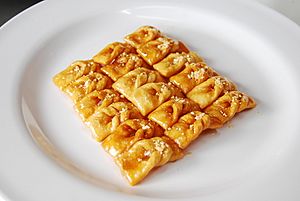Maejap-gwa facts for kids
 |
|
| Alternative names | Maejak-gwa, tarae-gwa |
|---|---|
| Type | Yumil-gwa |
| Place of origin | Korea |
| Associated national cuisine | Korean cuisine |
| 150 kcal (628 kJ) | |
| Korean name | |
| Hangul |
매잡과
|
|---|---|
| Hanja |
梅雜菓
|
| Revised Romanization | maejap-gwa |
| McCune–Reischauer | maejap-kwa |
| IPA | [mɛ.dʑap̚.k͈wa] |
| Hangul |
매작과
|
| Hanja |
梅雀菓
|
| Revised Romanization | maejak-gwa |
| McCune–Reischauer | maejak-kwa |
| IPA | [mɛ.dʑak̚.k͈wa] |
| Hangul |
타래과
|
| Hanja |
--菓
|
| Revised Romanization | tarae-gwa |
| McCune–Reischauer | t'arae-kwa |
| IPA | [tʰa.ɾɛ.ɡwa] |
Maejap-gwa (매잡과; 梅雜菓) is a yummy traditional Korean sweet snack. It's also known as maejak-gwa (매작과; 梅雀菓) or tarae-gwa (타래과). This treat is shaped like a pretty ribbon and is a type of hangwa, which means it's a traditional Korean confection.
Contents
How to Make Maejap-gwa
Making maejap-gwa involves a few fun steps. It's a bit like making a special kind of cookie or doughnut!
Mixing the Dough
First, wheat flour is mixed with ginger juice and water. This creates a soft dough. The ginger gives it a unique, slightly spicy flavor.
Shaping the Ribbons
Once the dough is ready, it's rolled out very thin. Then, it's cut into small rectangles. Each rectangle gets three cuts in the middle. One end of the rectangle is then pulled through the middle cut, making a pretty ribbon shape. This is how it gets its famous look!
Frying and Finishing
These ribbon shapes are deep-fried until they are golden and crispy. After frying, they are coated in sweet honey or a special syrup called jocheong. To finish, chopped pine nuts are sprinkled on top. This adds a nice crunch and nutty taste.
Gallery
-
Walnut jeonggwa (left) and maejap-gwa (right), from an Asiana Airlines in-flight meal
See also
 In Spanish: Maejakgwa para niños
In Spanish: Maejakgwa para niños


